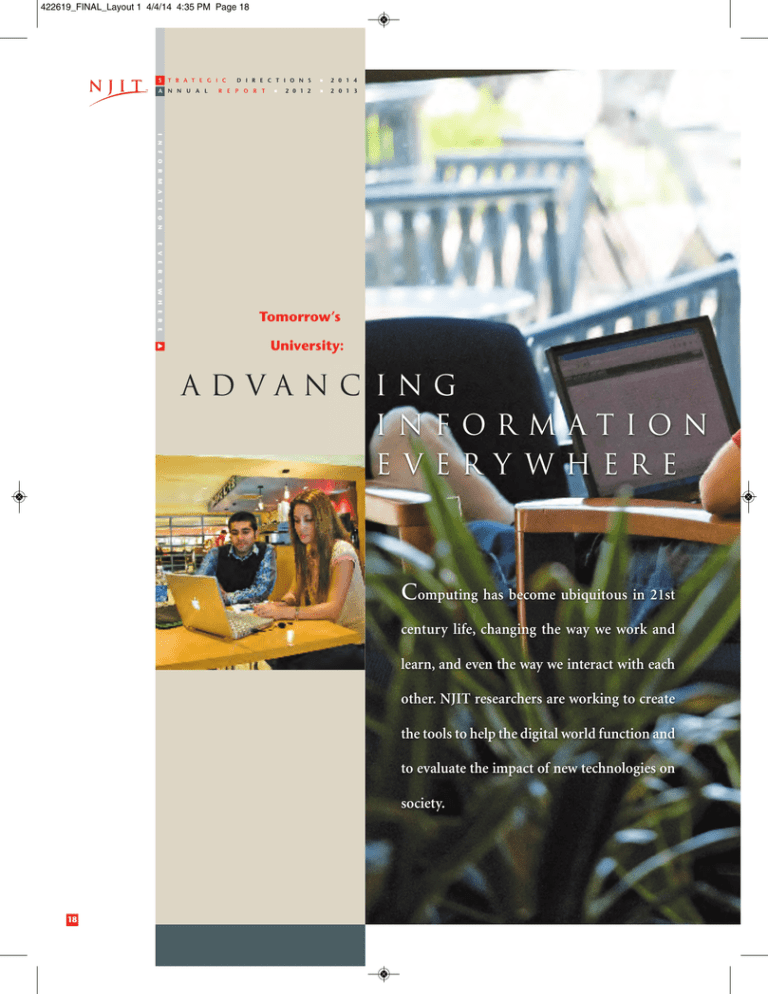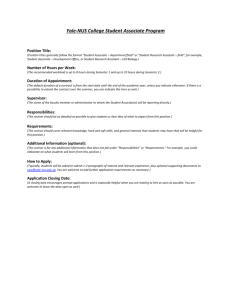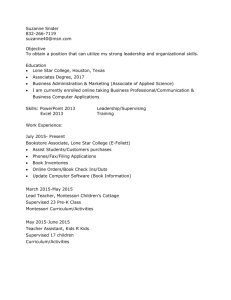i n g A d v a n c
advertisement

422619_FINAL_Layout 1 4/4/14 4:35 PM Page 18 S T R A T E G I C A N N U A L D I R E C T I O N S R E P O R T ■ 2 0 1 2 ■ 2 0 1 4 ■ 2 0 1 3 I N F O R M A T I O N ▼ E V E R Y W H E R E Tomorrow’s University: Advanc ing I n form ation E v e r y w h e re Computing has become ubiquitous in 21st century life, changing the way we work and learn, and even the way we interact with each other. NJIT researchers are working to create the tools to help the digital world function and to evaluate the impact of new technologies on society. 18 422619_FINAL_Layout 1 4/4/14 4:35 PM Page 19 I N F O R M A T I O N Studying New Media A team of computer science researchers is sensing of the physical world by leveraging the cameras, microphones, GPSs, accelerometers, and other sensors on the phones. Associate Professor Cristian Borcea (below left), Manoop Talasila (below center), doctoral student, and Associate Professor Reza Curtmola (below right), ▼ carried by people can be used for large-scale E V E R Y W H E R E studying how the collection of smart phones are collaborating with the University of Bologna, Italy, to find ways to manage and utilize the mobile crowd-sensing process. In order to verify that smartphone sensing is scalable, reliable, and cost-effective, they built and deployed McSense, a geo-social crowd sensing platform for smart cities. McSense has been deployed as an app for Android and is currently being tested by student volunteers. Julia Mayer (below), a doctoral student specializing in human-computer interaction, is researching social inference – the information that can be deduced about an individual’s identity, background, location ences and from preferdata available in social computing applications. She is working to evaluate the risks and benefits of social inference, and to develop user interfaces that would help users to manage social inferences. She is collaborating with Richard Schuler, PhD student in information systems, and Quentin Jones, associate professor of information systems. 19 422619_FINAL_Layout 1 4/1/14 5:22 PM Page 20 I N F O R M A T I O N ▼ E V E R Y W H E R E Andrzej Zarzycki (above), associate professor of science, is studying image forgery, which architecture and design, combines crowd sourc- has been facilitated by advances in image- ing with gaming to develop the concept of aug- editing software. In collaboration with Gavin mented reality. In a paper, “Urban Games: Lynch, doctoral student, and researchers at the Applications of Augmented Reality,” presented Academia Sinica in Taiwan, he has developed at SIGGRAPH Asia 2012, he described aug- an algorithm to detect copy-move forgery – mented environments that integrate history/ forgery in which one region of an image is knowledge, tourism, gaming and everyday copied to another area of the image in an at- urban life. The project utilizes a mobile app tempt to cover a potentially important feature. called Mystery Spaces that encourages users to Experimental results show the new method is become urban explorers and discover the effective in identifying the size and shape of the mystery of abandoned public infrastructure by duplicated region. navigating through forgotten and underappreciated public spaces. The project “gamifies” traditional sightseeing by awarding participants experience and discovery points, and encouraging authoring of the augmented reality environment content. Professor of MIS Katia Passerini (right) won a Bright Idea Award sponsored by the Stillman School of Business at Seton Hall University and the NJPRO Foundation for her paper entitled, “The Next Web Apps Architecture: Challenges tion among large and small vendors, and the for SaaS Vendors,” reviewing the dynamic evo- sustainability of profits for multiple service lution of the information technology industry providers. She co-authored the article with with the advent of cloud computing and high- Stephane Gagnon and Veronique Nabelsi of the lights key issues that will drive markets and busi- University of Quebec, and Kemal Cakici of the ness models on the cloud. Such issues are International Finance Corporation (IFC). beyond technical, and include the emergence 20 of marketplaces for services, the advent of the An expert in digital forensics and steganogra- “utility” and on-demand model, the competi- phy, Frank Y. Shih (right), professor of computer 422619_FINAL_Layout 1 4/1/14 5:22 PM Page 21 T R A T E G I C N N U A L D I R E C T I O N S R E P O R T ■ 2 0 1 2 ■ 2 0 1 4 ■ 2 0 1 3 I N F O R M A T I O N E V E R Y W H E R E Advancing Digital Design ▼ S A NJIT interior design students displayed their work at the 2013 NeoCON Student Work Exhibit in Chicago. Peter Fritzky’s Integrated Office Design (above); Mina Liba’s designs (left) show a plan for a relocation of the School of Art + Design; and Nora Hamade’s take on the same project (below). 21 422619_FINAL_Layout 1 4/1/14 5:22 PM Page 22 S T R A T E G I C A N N U A L D I R E C T I O N S R E P O R T ■ 2 0 1 2 ■ 2 0 1 4 ■ 2 0 1 3 I N F O R M A T I O N ▼ E V E R Y W H E R E Creating Business Applications For the third consecutive year, NJIT hosted one of the international sites for Global Game Jam. Design and information technology students collaborated on interdisciplinary teams to create 11 games for various web and mobile platforms. Digital design students Elvin Padilla, Rachel Corres and Danielle Esmaya (above), and IT student Louis Arcilla (standing) consult about their game submission. 2-D characters, called Lil Phobias (right), created by Rachel Corres. Of the 278 images selected for exhibit in the ACM/SIGGRAPH Curated Student Work Exhibit in Los Angeles, 48 were from the College of Architecture and Design, the work of 38 students. Shown here are some samples of the work that Developing New Technologies and Infrastructure was displayed. Interior Design by Amana Dewitt (above top) and Hsin Ting Hsieh (above bottom); Digital Design by (right, top to bottom): Brandon Simms, Elvin Padilla, Danielle Esmaya, and Kwasi Amankona. 22 422619_FINAL_Layout 1 4/1/14 5:22 PM Page 23 risk identification and early warning, such as iron analysts, and others. Once quantified, the results and steel, real estate and equipment management are used as explanatory variables in existing mod- industries, and bank liquidity risk warning index els of corporate/market behavior. In one study, in system. His new book, Swindlers, Fools and Mani- collaboration with Georgia Institute of Technol- acs, looks at financial asset bubbles, crises, irra- ogy, he examined whether “soft” information tional investment behaviors and financial frauds present in merger and acquisition announcement in the 5000-year history of China. press releases contains incrementally valuable news relative to traditional hard data and analyst Boil, Bubble, Toil and Trouble is the first book pub- Ali Akansu (below), professor of electrical and generated information. He found that expressions lished by the Leir Center for Financial Bubble computer engineering, studies financial applica- of managerial optimism are inversely related to Research, directed by William Rapp (above), Henry tions for high performance signal processing. At performance, discounted by the market, which is J. Leir Professor of International Trade and Business. the 38th IEEE International Conference on meaningful information to investors. An outgrowth of the 2nd Leir Conference on Acoustics, Speech and Signal Processing in Bubbles and Government Policies, the book seeks Va n c o u v e r, to define a financial bubble and how to recognize Canada, he a bubble before it bursts. Contributing authors in- gave a tutorial clude Rapp, Assistant Professor Alan Yan, Professor with Professor Mark Somers, Danielle Viola, ’13 MBA, Professor Ilya Pollak of Rajiv Mehta, Assistant Professor Wei Xu, and Pro- Purdue Univer- fessor Michael Ehrlich, associate director of the sity on “High center. Frequency ▼ warning for studying macroeconomic risk; industry to analyze the writing of investors, management, E V E R Y W H E R E the center will focus on methodologies of early (below) uses advanced computer methodologies I N F O R M A T I O N Assistant Professor of Management James Cicon Tr a d i n g a n d Associate Professor of Signal Process- Finance Zhipeng Alan ing Models for Yan (right) has estab- the Microstruc- lished the LIXIN-NJIT ture of Finan- Economic Risk Early cial Markets,” and co-organized and chaired a Warning Center with special session on “Financial Signal Processing and a grant from Shang- Electronic Trading.” He presented two papers on hai Lixin University of portfolio risk analysis with his doctoral students, Commerce. An interdisciplinary research venue, Mustafa Torun and Onur Yilmaz. Mengchu Zhou, distinguished professor of electri- Distinguished Professor Doctoral student Zhiqian Wang (below right), cal and computer engineering, will be leading the Yeheskel Bar-Ness (left), working in collaboration with Somenath Mitra newly-established CSRZIC Laboratory for Rail executive director of the El- (below left), distinguished professor of chemistry System Network and Information Technologies. isha Yegal Bar-Ness Center and environmental science, has developed a for Wireless Communica- lightweight, flexible tions and Signal Process- battery using carbon ing Research, gained two new patents to improve nanotubes orthogonal space time codes and decode data with printing meth- along transmissions. Co-inventors are his former doctoral ods that offers the students, Amir Laufer’11 and Kodzovi Acolatse ’10. potential for high throughput fabrica- Abdallah Khreishah (right), assistant tion/manufacture of Funded by the CSR Zhuzhou Electric Locomotive professor of electrical and computer printed batteries and super capacitors. These new Research Institute Co., the center will utilize NJIT’s engineering, studies the latest work batteries have the potential to provide easy trans- expertise in signal processing to develop wireless in computer networking with an portability and integration into small electronics, communication and control technologies to allow emphasis on improving the flow of such as rollup displays, wearable devices, electronic passengers traveling on high-speed trains to com- information. With a grant from the National Sci- identification tags, smart cards, and implanted municate with each other and outside the trains ence Foundation, he is working to improve the medical devices. Their findings were recently pub- via the Internet. capacity and energy efficiency of wireless net- lished in the Journal of Power Sources. works with different processing capabilities. 23 422619_FINAL_Layout 1 4/1/14 5:22 PM Page 24 S T R A T E G I C A N N U A L D I R E C T I O N S R E P O R T ■ 2 0 1 2 ■ 2 0 1 4 ■ 2 0 1 3 I N F O R M A T I O N Out of Data ▼ E V E R Y W H E R E Getting the Most Mei Liu (left), assistant Lian Duan, assistant professor of information Doctoral student Ankur Agrawal (below) was nom- professor of computer systems (above left), with his graduate student inated as a finalist in the student paper competi- science, is developing Yanchi Liu, conducts innovative research on large- tion at the World Congress on Medical and Health data-mining methodolo- scale data mining, using correlated sets of arbi- Informatics for his paper “Identifying Problematic gies to uncover clinical trary, rather than the more usual correlated pairs. Concepts in SNOMED CT knowledge from elec- In a recent study, he applied his technique to elec- Using a Lexical Approach,” tronic medical records tronic health records to collect information about which presents an innova- that improve the quality, adverse reactions to drug therapies. His findings tive lexical methodology to safety and efficiency of were published in the IEEE Journal of Biomedical and identifying inconsistencies in Health Informatics. large medical terminologies healthcare. In a recent study, she demonstrated that electronic medical records can validate previously such as SNOMED CT with reported adverse drug reactions and report new Jason Wang (below), professor of computer science ease and efficiency. Agrawal ones. “Comparative Analysis of Pharmacovigilance and director of the Data and Knowledge Engineering is part of the research team Methods in Detection of Adverse Drug Reactions Laboratory, develops software tools and search en- led by Professor Yehoshua from Electronic Medical Records,” published in the gines to simplify — by analysis and classification — Perl (right) that focuses on Journal of the American Medical Informatics Associa- large terminological data- tion, examined the use of retrospective medication bases. His work continues orders and inpatient laboratory results documented the team’s ongoing efforts to develop a simplified, in medical records to identify adverse reactions. compact semantic network to organize the large, complex clinical databases used in hospitals. Associate Professor of Mathematical Science Ji Meng Loh (right) specializes in applied spatial data Yi Chen (below), associate professor of manage- analysis and visualization and ment, focuses her research on semi-structured data, the development of statistical such as databases, documents, workflows and social methodology to make better huge amounts of biological data. A recent paper networks. She has an NSF CAREER grant and a inferences from spatial data. In published by his research team in OMICS: A Journal Google Research Award to develop high quality key- a recent study, he examined of Integrative Biology outlines a method to distin- word search results on semi-structured data in XML, visitor volume to Morristown, guish between microRNA precursor transcripts the ubiquitous mark-up lan- NJ, on workdays, on weekends, and for the St. which play an important role in biological guage designed to store and Patrick’s Day Parade, by analyzing cellular data. In processes such as cell proliferation, tissue differen- transport data. The goal is to another study, funded by the Robert Wood John- tiation, and embryonic development from simi- enable the vast amount of in- son Foundation’s Healthy Eating Research and larly constructed pseudo pre-miRNAs. The project formation in databases to be- New Connections Program, he investigated the is part of a long-term initiative to build a cyber in- come “Google-able.” A second spatial relationship between fast food and schools, frastructure for RNA data analysis and mining that NSF project, also funded by an and the role of school and neighborhood segre- would allow researchers to uncover patterns with IBM Faculty Award, addresses mining and optimiz- gation in shaping these relationships. potential applications in the detection of genetic ing ad hoc workflows such as those in customer diseases, the classification of DNA sequences, the service, problem solving and decision-making. prediction of RNA and protein secondary and tertiary structures, and rational drug design. 24


